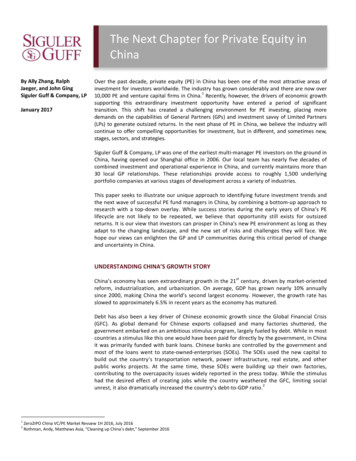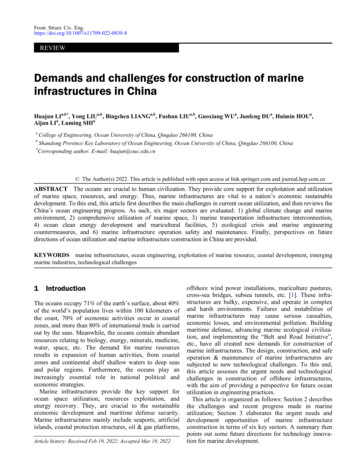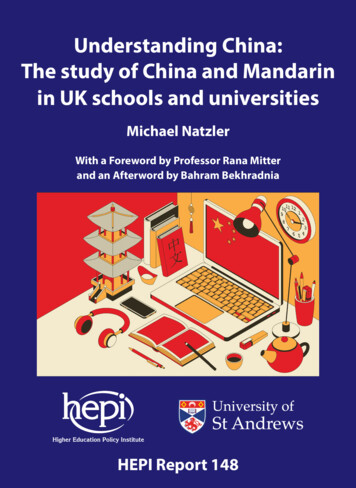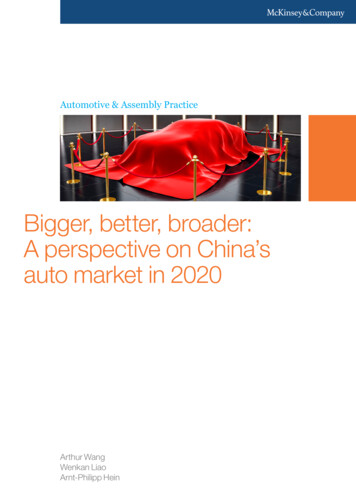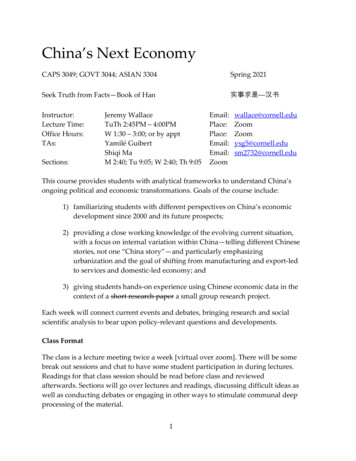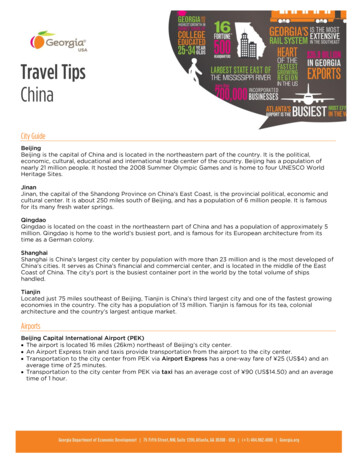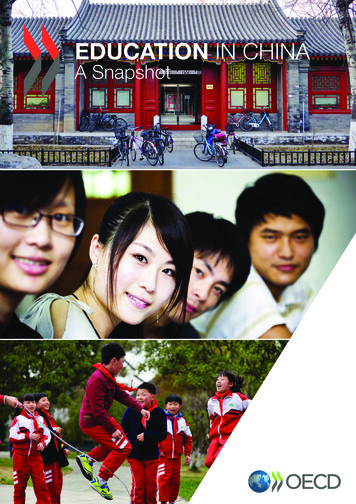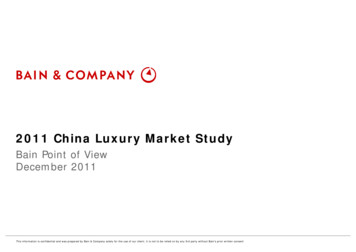
Transcription
Rethinking Investments inNatural Resources:China’s Emerging Role in the Mekong Region2008
Rethinking Investments in Natural Resources:China’s Emerging Role in the Mekong RegionWritten by:Jeff Rutherford, Kate Lazarus and Shawn KelleyEdited by:Ingrid MartonovaGraphic Design by:Peter StannardProduced in 2008 with the support of:Heinrich Böll Stiftung Cambodia#34 Street 222, Sangkat Boeung Raing, Khan Daun PenhP.O. Box 1436, Phnom Penh, CambodiaTel: ( 855) 023 210 535Fax: ( 855) 023 216 482E-Mail: phnompenh@hbfasia.orgWebsite: www.boell-southeastasia.orgWWF DenmarkRyesgade 3 F2200 Copenhagen NDenmarkTel: ( 45) 035 36 36 35Fax: ( 45) 035 24 78 68E-mail: wwf@wwf.dkWebsite: www.wwf.dkInternational Institute for Sustainable Development.161 Portage Avenue East, 6th FloorWinnipeg, Manitoba, R3B 0Y4CanadaTel: ( 1) 0204 958 7700Fax: ( 1) 0204 958 7710E-mail: info@iisd.caWebsite: www.iisd.org, www.tradeknowledgenetwork.netCopyright 2008 - Heinrich Böll Stiftung, WWF and International Institute for Sustainable Development.
Table of ContentsAcknowledgementsAcronymsList of Tables and BoxesExecutive Summary1 Introduction1.1 Scope and Methods2 Lao People’s Democratic Republic2.2 Introduction2.1.1 Foreign Direct Investment2.1.2 Official Development Assistance2.1.3 Trade2.2 Investment Regulations2.3 Stakeholders and Decision-making Processes2.4 Sectors2.4.1 Agribusiness2.4.2 Hydropower2.4.3 Mining3 Vietnam3.1 Introduction3.1.1 Foreign Direct Investment3.1.2 Official Development Assistance3.1.3 Trade3.2 Investment Regulations3.3 Stakeholders and Decision-making Processes3.4 Sectors3.4.1 Agribusiness3.4.2 Hydropower3.4.3 Mining4 Cambodia4.1 Introduction4.1.1 Foreign Direct Investment4.1.2 Official Development Assistance4.1.3 Trade4.2 Investment Regulations4.3 Stakeholders and Decision-making Processes4.4 Sectors4.4.1 Agribusiness4.4.2 Hydropower4.4.3 Mining5 China’s Policies for Overseas Investment6 Conclusions7 30333334384141414242434346464950535559
AcknowledgementsThis report was written by Jeff Rutherford, Kate Lazarus and Shawn Kelley. The authors wouldlike to thank the following individuals for their in-country research assistance: For the sectionon Vietnam, Ms. Nguyen Thi Hien, Central Institute for Economic Management and Mr. PhamQuang Tu, Consultancy on Development. For the section on Laos, Dr. Leeber Leebouapao,National Economic Research Institute. For the section on Cambodia, Mr. Sovannara Lim,Cambodia Development Resource Institute.The authors would also like to thank John Dore, Nathan Badenoch, Katrin Seidel, RuthStreicher, Heike Baumüller, John Kornerup Bang, Teak Seng, the participants in the threenational consultations and the many people interviewed for this research for providing relevantinformation and comments on this report.Project DescriptionThis scoping study is part of a research project entitled Understanding China as an Actorin the Mekong Region, jointly implemented by the Heinrich Böll Stiftung, WWF and theInternational Institute for Sustainable Development. The project aims to shed some light onChina’s economic role in Vietnam, Laos and Cambodia as a basis for constructive dialoguebetween decision makers and other stakeholders in China and the Mekong countries. Theresearch focus is on Chinese investments in natural resources – in particular in the mining,agribusiness and hydropower sectors – while also touching on issues related to trade and aid.In addition to the scoping study, case studies in the three countries will provide a more indepth analysis of China’s engagement in specific sectors. The project outputs will be availableat: www.boell-southeastasia.org, www.tradeknowledgenetwork.net and www.wwf.dk.Rethinking Investments in Natural Resources:China’s Emerging Role in the Mekong RegioniiAcknowledgements
OICMONREMOUMPIMWNGPESASEAN-China Free Trade AgreementAsian Development BankASEAN Free Trade AreaAsia-Pacific Economic CooperationAssociation of Southeast Asian NationsBusiness co-operation contractCountry Action PlanCouncil for the Development of CambodiaCommon Effective Preferential TariffCambodian Investment BoardCentral Institute for Economic ManagementConsultancy on Development (Vietnam)Committee for Planning and Investment (Laos)Cambodian Rehabilitation and Development BoardChina International Water and Electric CorporationDepartment of Domestic and Foreign Investment (Laos)Department of Natural Resources and Environment (Vietnam)Department of Planning and InvestmentElectricity Authority of CambodiaElectricité de LaosEarly Harvest ProgramEnvironmental Impact AssessmentElectricity Regulatory Agency of VietnamElectricity of Vietnamforeign direct investmentGross Domestic ProductGlobal Environment InstituteGreater Mekong SubregionGovernment of LaosHarmonised SystemInternational Finance CorporationInternational Financial InstitutionInternational Monetary FundInvestment Promotion Department (Laos)kilovoltMinistry of Agriculture and Forestry (Laos)Ministry of Agriculture, Forestry and Fisheries (Cambodia)Ministry of Energy and Mines (Laos)Multilateral Investment Guarantee Agency (World Bank)Ministry of Industry, Mines and Energy (Cambodia)Ministry of Commerce (China)Ministry of Industry and Commerce (Laos)Ministry of Natural Resources and Environment (Vietnam)Memorandum of UnderstandingMinistry of Planning and Investment (Vietnam) and (Laos)megawattNational Growth and Poverty Eradication Strategy (Laos)Rethinking Investments in Natural Resources:China’s Emerging Role in the Mekong RegioniiiAcronyms
AWREAWTOnon-governmental organisationnon-timber forest productofficial development assistanceOrganisation for Economic Co-operation and DevelopmentProject Development AgreementRoyal Government of CambodiaPrime Minister’s Office (Laos)Round Table ProcessState Administration of Foreign Exchange (China)State Environmental Protection Administration (China)Special Economic ZoneSocial Impact Assessmentstate-owned enterpriseUS dollarVietnam Union of Science and Technology AssociationsWater Resources and Environment Administration (Laos)World Trade OrganisationList of Tables and BoxesTable 1:Table 2:Table 3:Table 4:Table 18:Table 19:Approved FDI to Laos by top Countries: January 2001-March 2008Important regulations for foreign investment in LaosApproved FDI to Laos by top Sectors: January 2001-March 2008Chinese companies Investing in rubber productionin Luang Namtha ProvinceHydropower projects in Laos financed with Chinese investmentsMining licenses awarded to international companies operatingin Laos: 2006-08Mining Projects in Laos supported by Chinese companies: 2007China’s FDI in Vietnam by form of InvestmentImportant regulations for foreign investment in VietnamAgricultural exports from Vietnam to China: 1996-20066th Power Master Plan Base Power Source ProjectionsExisting Hydropower Plants in VietnamPlan for the construction and operation of hydropower plantsin Vietnam with capacity exceeding 50MW: 2003-2010Plan for the construction and operation of hydropower plantsin Vietnam with capacity Exceeding 50MW after 2010Chinese investments in Vietnam’s mining sectorRecently enacted trade and investment laws and regulationsin CambodiaKnown economic land concessions owned by Chinese nationalsin CambodiaChinese-led hydropower Projects in CambodiaKnown Mineral Operations by Chinese Companies in CambodiaBox 1:Who is Sinohydro?Table 5:Table 6:Table 7:Table 8:Table 9:Table 10:Table 11:Table 12:Table 13:Table 14:Table 15:Table 16:Table 17:Rethinking Investments in Natural Resources:China’s Emerging Role in the Mekong t of Tables and Boxes
Executive SummaryChina is establishing itself as an economic powerhouse around the world. China’s economicrise and consequent demand for a reliable and steady supply of inexpensive natural resourceshave led to a rapid increase in Chinese foreign direct investment (FDI) stretching all the way toAfrica and Latin America. The backdrop for China’s growing relationship with natural resourceproviding countries is regional and global economic integration, which is increasinglyinterlinking different parts of the world in complex value-chain arrangements. This globaleconomic system links countries belonging to the Organisation for Economic Co-operationand Development (OECD), which are the main consumers of world products, with low-incomecountries, which provide the majority of natural resources on which the production of goodsis based. The connection is made by manufacturing countries that turn natural resources intoinexpensive manufactured goods for export and sale in OECD markets. Within this globalsystem, China over the past decade has emerged as one of the main global production andmanufacturing hubs.During the first half of 2005, Chinese enterprises invested 4.1 billion overseas, an increase ofnearly 250 percent over the previous year. In 2005, the outward investments of Chinese nonfinancial enterprises increased by 20 percent compared to 2004 to reach 12.3 billion. In thefirst three quarters of 2006, China’s total outward investment amounted to 14.1 billion, anincrease of 80 percent year on year, and estimates pegged total outward investment at 16billion by the end of year. Given China’s rapid industrial expansion and limited domesticnatural resources, it is not surprising that mining and energy are key sectors in China’s foreigndirect investment portfolio. China’s export credit and guarantee agencies, in particular theChina Export Import (Exim) Bank and Sinosure, have played an important role in fostering therapid expansion of Chinese trade and re-thinking of China’s southward investment flows. In2005, China Exim Bank approved loans to the value of RMB 158.6 billion (approximately 20billion). Established only in 1994, the institution has grown to become one of the world largestexport credit agencies.Partly as a result of China’s rapidly growing demand for natural resources, commodity pricesare rising around the globe. Investments in extractive industries that were once prohibitive arenow making economic sense. In 2002, China became the world’s largest consumer of copper,and it is now one of the largest consumers of alumina, zinc and nickel. In 2002 China alsobecame the world’s largest consumer of natural rubber, bypassing the US at 3.45 million tons,or 18.2 percent of total world consumption. China’s demand for natural rubber is estimated toreach 11.5 million tons per annum by 2020, about 30 percent of the world’s total production.This growth is directly linked to China’s growing demand for vehicles, which is estimated toreach 200 million vehicles by 2020, a vast increase from the 10 million vehicles that traversedthe country in 2005.China’s ‘Going Out’ Strategy to meet its growing natural resourcesdemandChina’s economic relationship with the world is undergoing a rapid transformation. The 10thFive-Year Plan for National Economic and Social Development (2001-2005) set out a strategyfor China to proactively make use of overseas natural resources, establish overseas supply basesfor both oil and gas, diversify oil imports, build up a strategic petroleum reserve and maintainnational energy security. Since 2004, the country’s ‘Going Global’ (or ‘Going Out’) Strategyspecifically intends to meet its growing demand for natural resources, both regionally as wellas globally, and spur outward investment by subsidising investment by Chinese companiesin overseas natural resources acquisition. The strategy and its related initiatives include theRethinking Investments in Natural Resources:China’s Emerging Role in the Mekong Region Executive Summary
promulgation of guidelines on outward FDI by countries and sectors, information regardingforeign countries’ investment environment and opportunities, delegation of authority by thecentral government to certain provinces and municipalities and further relaxation of foreignexchange controls for outward investment.The Chinese government has made laudable efforts to develop policies and guidelines togovern overseas aid and foreign direct investment. While this is still a nascent process, it hasgreat potential for addressing and mitigating potential conflicts over investments in sensitiveprojects such as hydropower dams, strip mines and large-scale plantations. However, manychallenges remain, as demonstrated by the guidelines for Chinese overseas investments insilviculture operations, which stipulate that Chinese companies should adhere to the laws ofthe countries in which they operate. In the case of the Mekong region, these laws are widelyrecognised as being poorly implemented. Were Chinese companies to operate as loosely asnational companies when it comes to forestry or environmental regulations, this would notmake for an improvement in business practices. The real leverage promised by such guidelinesis that Chinese companies that bypass local regulations would not only be in violation of thelaws of the host countries, but would in fact be in violation of the laws of China.China’s strategy in the Mekong regionChina’s relationship with the three Mekong Region countries Cambodia, Lao People’sDemocratic Republic (Laos) and Vietnam is dynamic and complex. On the one hand,relations have never been so good. Border and sea issues are handled peacefully, eclipsed byeconomic interests. The close proximity of these countries eases trade flows as infrastructureimprovements are connecting major regional cities and borders are open for business throughinternational gates.The future promises greater economic integration through the ASEAN (Association of SoutheastAsian Nations)–China Free Trade Agreement (ACFTA) which will see progressive liberalisationof trade and investment between the two trading partners over the coming years. Under theACFTA’s Early Harvest Programme, tariffs on around 600 unprocessed agricultural productswere already eliminated by January 2006. China’s major investments within the GreaterMekong Subregion (GMS) Economic Strategy have improved the infrastructure for transportingcommodities, in part through the Asian Development Bank’s (ADB) GMS Economic Corridors,which includes a network of roads connecting all countries in the GMS spanning Vietnam,Cambodia, Laos, Thailand, Myanmar and Yunnan Province of China. Further connectivity isextended through an expanding regional power grid and planned railway links from Kunmingto Singapore, funded in part through development assistance and investment from China. Allthis has enabled China to build strong bilateral and multilateral relations through investment,trade and aid with its southern neighbours and protect itself from further western influencesby securing its border areas through friendly relations.In recent years, Cambodia, Laos and Vietnam have seen two related trends working inopposite directions. The first is the partial withdrawal of International Financial Institutions(IFIs) such as the World Bank and the Asian Development Bank (ADB), which have becomehesitant to invest in environmentally and socially controversial mega-projects. In recent yearsthe IFIs have developed international standards and best practices for investment in projectswith potentially large social and environmental impacts, such as hydropower, mining andindustrial agriculture. These standards are often criticised by host governments as beingonerous and cumbersome and it can take years for projects to get approved. This has left aninvestment vacuum that has been gradually filled by largely Asian financiers, and has enabled‘new financiers’ such as Chinese companies to take advantage of the favourable investmentclimate and abundance of natural resources of its immediate neighbours.Rethinking Investments in Natural Resources:China’s Emerging Role in the Mekong Region Executive Summary
Currently, Chinese investment banks and companies are not yet bound to similar standardsin their overseas activities, even though they may be required to follow them in their homecountries. China brings a different kind of investment package to the table: one that does nothave benchmarks of compliance with human rights, democratic ideals and environmentalprotection regulations, but is built on relationships and friendship. China is also seen as a‘soft power’ of culture and ideas, one making friends all across the region, with friendshipspearheading business activities. For example, the Chinese government has supported theconstruction of several important cultural and state buildings, such as the National CulturalHall in Laos and the new office of the Council of Ministers in Cambodia.However, the role of China is perceived differently within Cambodia, Laos and Vietnam as wellas across different social strata. The question of Chinese ethnicity is a complex and sensitivesubject, with millions of people who were born and raised in the three lower Mekong countriesclaiming Chinese heritage. Vietnam, naturally, carries the collective memory of China as ahistorical colonial power. The Cambodian government is welcoming of Chinese influenceand capital, but there are concerns in the countryside about dams and other Chinese-fundedinvestment projects. The divergence between the perspectives of the elite and the grassrootson the growing influence of China presents considerable challenges for Cambodian, Lao andVietnamese leaders. Where a civil society is emerging, people have begun to voice oppositionto Chinese investment interests, as in the case of the Spratly Islands, an oil-rich area in theSouth China Sea. In Laos, where there are no formal civil society institutions, there has so farbeen no public outcry against the influx of Chinese immigrants who accompany investments.However, public concern over the proposed construction of a Chinatown satellite city inVientiane has been widely documented in various newspapers, newswires and listserves.China’s emerging role in finance and trade in Cambodia, Laos andVietnamIn the Mekong region, China is gaining prominence as an important bilateral trading partnerand investor while at the same time emerging as a strong competitor for global marketsand investments with its southern neighbours. China produces almost half of the East andSoutheast Asian region’s gross domestic product (GDP) and one third of the region’s exports.While China and Vietnam compete for foreign direct investment and markets around theworld, China has also become Vietnam’s leading trading partner. Further, China is the mostimportant donor and foreign investor in Laos and Cambodia.Official development assistanceThe Chinese government provides considerable foreign aid to Cambodia, Laos and Vietnam,often without any major conditions attached and frequently integrated with cultural exchangeand support. While significant compared to other donors, China’s ODA is not often linked tothe agribusiness, hydropower and mining sectors but mostly includes support for transport;communications; health, education and human resources development; and construction(of sports, culture and government building complexes) sectors. Cambodia is the onlycountry among the three where the Chinese government has earmarked aid for hydropowerdevelopment projects.China’s trade structure with its neighbours – importing resources, exportingmanufactured goodsChina’s trade structure with Cambodia, Laos and Vietnam is presently dominated by China’simports of natural resources and exports of manufactured goods. More than 90 percent ofexports from the three GMS countries to China comprise agricultural goods and raw materials.This stands in marked contrast to the structure of trade between China and some otherSoutheast Asian countries such as Malaysia, the Philippines and Thailand, where the tradeRethinking Investments in Natural Resources:China’s Emerging Role in the Mekong Region Executive Summary
structure is more complex and exports to China are less resource-intensive. While the relativeimportance of investment and trade with China varies among the three countries, what theydo sell to their large northern neighbour is overwhelmingly commodities. What they buy ismostly Chinese technology, machinery and consumer goods, many of which are of low quality,but within reach of poorer consumers in Cambodia, Laos and Vietnam.Informal (or illegal) trade in commodities is widespread in the three Mekong countries. Forinstance, some state officials in Vietnam estimate that the majority of the coal and rubberexported to China is informal, with no duties paid to the state and no records of the exportedtonnage and value. In northern Laos it is widely known that companies from China are settingup informal operations for commodities such as sugar, cassava, corn and timber, which arethen transported across the border. In parts of Cambodia it is generally suspected, thoughnot formally confirmed, that several Chinese companies are involved in informal ventures intimber, gold and other minerals destined for markets in China.The principal difference among the three countries in their relationship with China is inthe relative importance of investment and foreign assistance versus trade in relation to theagribusiness, hydropower and mining sectors. In Cambodia and Laos, Chinese investment inall three sectors is considerable. For Vietnam, on the other hand, China is only the fifteenthlargest overall investor, and Chinese investment is considerable only in the mining sector.Vietnam itself is a regional leader in hydropower and mining, with its own investments inLaos and Cambodia, and it has extensive experience in growing rubber, also with investmentsin neighbouring countries. For Vietnam, trade with China, its largest trading partner, is mostsignificant in the three surveyed sectors.China’s investments in agribusiness, hydropower and miningThe natural resource sectors of the three Mekong countries have long been described as underdeveloped. However the emergence of China as a major investor in the three sectors as well as aprincipal market promises fundamental changes in the landscapes and societies of the region.Chinese state-owned enterprises are becoming major investment players in Cambodia, Laosand Vietnam and fuelling natural resources extraction. For instance, the China NonferrousMetals International Mining Co. Ltd. (CNMIC) is active in copper mining in Vietnam andbauxite mining in Laos. Chalco (Aluminium Corporation of China) has partnered with Thaiand Lao companies to put forward an environmental impact assessment for bauxite mining inthe same area as CNMIC in Laos and is also engaged in Vietnam. The Sinohydro Corporation,the largest hydropower dam building company in China, is developing numerous hydropowerprojects in both Laos and Cambodia. And the China Southern Power Grid Co. Ltd. is eitheractive or exploring opportunities in all three countries.In spite of its high potential, hydropower has remained largely untapped. However, in Laosand Cambodia, China is involved in roughly 21 hydropower projects either as an investor ordeveloper. Most of the Chinese projects are designed and implemented by Chinese companiesand backed by the China Exim Bank and Sinosure, which are involved in the majority ofChina’s overseas investments. China’s current role in hydropower in Vietnam appears to bequite minor. There are no joint ventures, with most hydropower development carried out byVietnamese firms, formerly dominated by Electricity of Vietnam. However, China suppliesmost of the turbines and other equipment for small and medium hydropower and Vietnamcurrently imports 200MW of electricity from southern China. This is expected to increasetenfold by 2015, with projected imports of about 2,000MW.Mineral extraction has been small in scale and intensive in labour to date. However, in Laosalong the Bolaven Plateau and in the Central Highlands of Vietnam, China is starting to investin large tracts of land for bauxite mining to export aluminium for its growing construction,Rethinking Investments in Natural Resources:China’s Emerging Role in the Mekong Region Executive Summary
transportation and packaging industries. Other mining investments and/or exports in thethree countries include gold, copper, iron, zinc and coal. It is expected that China will remaina large market for minerals and a key investor in the region.Until recently, agricultural production in Cambodia and Laos was largely for local consumptionand lacked intensive inputs and practices. But those days are over. China provides a majorsource of investment capital for agricultural inputs in the two countries and is a principalmarket for goods in all three. Such commodities as cassava, sugarcane, corn, palm oil, cashewsand eucalyptus, among others, are major sources of investment by China in at least one ofthe three GMS countries. China’s rising demand for natural rubber, for example, has alreadyled its southern neighbours to convert large areas of land to rubber production. China is amajor investor in rubber production in Laos, although less so in Cambodia. And while China’sinvestment in Vietnam’s rubber sector is presently negligible, China is already the principalmarket for its rubber exports.Towards environmentally and socially sustainable ChineseinvestmentChina’s growing presence and role in the three Mekong countries raises new opportunitiesthrough foreign direct investment, trade and regional partnership. These new opportunitiescould play an important role in generating income for some of the poorest countries inSoutheast Asia and building closer regional ties for both China and the countries in which theyinvest. But the vastly expanding demand for investment opportunities, the porous borders thatfacilitate informal movement of goods and people and the limited local capacity and resourcesto implement various regulations in the three countries presents considerable risks to thesehoped for opportunities. These environmental and social risks can translate into significantimpacts on riverine ecosystems, agricultural lands and communities.China is starting to make efforts to improve its profile in the international arena by showingits willingness to take on board international best practices such as the Equator Principlesfor banks, public participation strategies and green credit policies, among others. However,many of the mainly state-owned Chinese companies operating in the mining and hydropowersectors continue to have a poor social and environmental track record abroad. China now hasthe chance to become a global leader in environmentally and socially sustainable investmentby carefully monitoring Chinese overseas investments, strengthening its own investmentregulations and adopting global best practices and principles. However, the onus cannot be onChina alone. China will need to partner with governments within the countries it operates inorder to help resource providers strengthen their own regulations, which does not necessarilyhave to come at the expense of investment inflows.Rethinking Investments in Natural Resources:China’s Emerging Role in the Mekong Region Executive Summary
1IntroductionChina’s relationship with Cambodia, Lao People’s Democratic Republic (Lao PDR) and Vietnamis dynamic and complex. On one hand, relations have never been so good. Border and seaissues are handled peacefully, eclipsed by economic interests. Infrastructure improvementsare connecting major regional cities, and borders are open for business through internationalgates. The future promises greater economic integration through the Association of SoutheastAsian Nations (ASEAN)-China Free Trade Agreement (ACFTA), and activities associated withthe Greater Mekong Subregion (GMS) Program.But the relationship is far from even. China is gaining prominence as a bilateral trading partnerand investor, while at the same time emerging as a strong competitor for global markets withits southern neighbours. China produces almost half of the East and Southeast Asian region’sgross domestic product (GDP) and one third of the region’s exports. While China and Vietnamcompete for foreign direct investment (FDI) and markets around the world, China has alsobecome Vietnam’s leading trading partner. Further, China is the number one foreign investorin Laos and Cambodia. The competition FDI is uneven: Over the past decade, China’s FDIinflows came close to 600 billion,1 while ASEAN members combined received just over halfthat amount ( 324 billion).2The background to China’s growing relationship with its southern neighbours is regional andglobal economic integration, which is increasingly interlinking different parts of the worldin complex value-chain arrangements. This complex economic system connects countriesbelonging to the Organisation for Economic Co-operation and Development (OECD),3 whichare the main consumers of world products, with low-income countries, which provide themajority of natural resources on which the production of goods is based. The connection ismade by producer countries that turn natural resources into inexpensive manufactured goodsthat are exported and sold on OECD markets. Within this global system, China has emergedover the past decade as one of the main global production and manufacturing hubs.During the first half of 2005, Chinese enterprises invested 4.1 billion overseas, an increase ofnearly 250 percent over the previous year. In 2005, the outward investments of Chinese nonfinancial enterprises amounted to 12.3 billion, a 20 percent increase over the previous year.In the first three quarters of 2006, China’s total outward investment reached 14.1 billion, anincrease of 80 percent year on year, and estimates pegged total outward investment a
China's export credit and guarantee agencies, in particular the China Export Import (Exim) Bank and Sinosure, have played an important role in fostering the rapid expansion of Chinese trade and re-thinking of China's southward investment flows. In 2005, China Exim Bank approved loans to the value of RMB 158.6 billion (approximately 20 .

